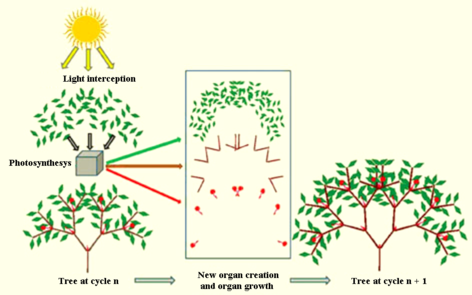GreenLab Course
Overview
Growth.
Plants are alive!
-
Plants grow slowly and they seem frozen in their architecture.
Growth: a dual mechanism
- cell multiplication in apical meristems, inside buds, building the various organs (leaves, internodes, wood rings, roots, etc. ),
- and, the expansion of these cells, allowing organ growth.
Plant growth
On a cell scale, two processes are basically involved in plant growth:
On a whole plant scale, growth thus results from this dual mechanism.
The organ creation phase is called organogenesis or development stage,
with the establishment of the plant architecture from new axes.
While organ growth up to maturation under the effect of photosynthesis
is called expansion or simply growth.

Plant growth and Plant architecture. (© Liama, CASIA).
- Leaves intercept light and produce biomass through the photosynthesis process.
Biomass is used for organ growth (size development) and for the creation of new organs in regular cycles.
These new organs build the plant's architecture.
Plant components
A plant is composed of 80% water, 15% sugars and 5% trace elements.
The photosynthesis process produces sugars, which are necessary as an energy source and for building the material for its growth.
Plant production material is called biomass.
The organogenesis and expansion processes both require new biological material, i.e. production of new biomass.
Building plant components
-
Water is taken up from the soil by the roots.
Sugars (cellulose), composed of water and CO2 from the atmosphere, are synthetized by the leaves.
It should be remembered that components such as trace elements (phosphorus, potassium, nitrate, ...) are essential to cellular mechanisms, but secondary in biomass production.
Sugar production requires energy. This energy is light, intercepted by the leaves.
The sugar production process is called Photosynthesis.
A specific point is that sugars arising from photosynthesis are both
- - fuels for plant functioning
- the basis of plant building material (cellulose)
For example, under saline conditions, more sugars are devoted to limiting salinity pressure, potentially stopping cellulose production.
